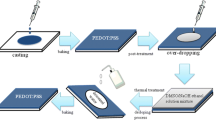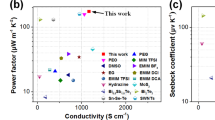Abstract
Organic thermoelectric materials based on conducting polymers, especially for polyaniline (PANi) and poly(3,4-ethylenedioxythiophene)/poly(4-styrenesulfonate) (PEDOT/PSS), have attracted great concern due to their tunable electron transport properties by controlling doping level. Here, the solvent effects of deionized H2O and NH3·H2O were investigated on the electrical conductivity and Seebeck coefficient of PANi/PEDOT/PSS composite films. The introduction of PEDOT/PSS can not only effectively improve the quality of pure PANi film, but also enhance the electrical conductivity of PANi film. The different volumes of deionized H2O as dilution have a great influence on the electrical conductivity of PANi/PEDOT/PSS composite thin film with a maximum electrical conductivity value of 63.5 S cm−1, which is much higher than pure PANi and pristine PEDOT/PSS. The introduction of NH3·H2O shows a positive effect on Seebeck coefficient with a large decline on electrical conductivity of PANi/PEDOT/PSS. The Raman spectroscopy, scanning electron microscopy (SEM), and UV-vis spectroscopy were used to obtain the morphology and structure information of PANi/PEDOT/PSS.





Similar content being viewed by others
References
Snyder GJ, Toberer ES (2008) Complex thermoelectric materials. Nat Mater 7:105–114
Zhang Q, Sun Y, Xu W, Zhu D (2014) Organic thermoelectric materials: emerging green energy materials converting heat to electricity directly and efficiently. Adv Mater 26:6829–6851
Chen Y, Zhao Y, Liang Z (2015) Solution processed organic thermoelectrics: towards flexible thermoelectric modules. Energy Environ Sci 8:401–422
He M, Qiu F, Lin Z (2013) Towards high-performance polymer-based thermoelectric materials. Energy Environ Sci 6:1352–1361
Yue RR, Xu J (2012) Poly(3,4-ethylenedioxythiophene) as promising organic thermoelectric materials: a mini-review. Synth Met 162:912–917
Jiang F, Xu J, Lu B, Xie Y, Huang R, Li L (2008) Thermoelectric performance of poly(3,4-ethylenedioxythiophene):poly(styrenesulfonate). Chin Phys Lett 25:2202–2205
Lee K, Cho S, Park SH, Heeger AJ, Lee CW, Lee SH (2006) Metallic transport in polyaniline. Nature 441:65–68
Ciric-Marjanovic G (2013) Recent advances in polyaniline research: polymerization mechanisms, structural aspects, properties and applications. Synth Met 177:1–47
Zhang Q, Wang W, Li J, Zhu J, Wang L, Zhu M, Jiang W (2013) Preparation and thermoelectric properties of multi-walled carbon nanotube/polyaniline hybrid nanocomposites. J Mater Chem A 1:12109–12114
Du Y, Shen SZ, Cai K, Casey PS (2012) Research progress on polymer–inorganic thermoelectric nanocomposite materials. Prog Polym Sci 37:820–841
Yao Q, Chen L, Zhang W, Liufu S, Chen X (2010) Enhanced thermoelectric performance of single-walled carbon nanotubes/polyaniline hybrid nanocomposites. ACS Nano 4:2445–2451
Wang L, Yao Q, Bi H, Huang F, Wang Q, Chen L (2015) PANI/graphene nanocomposite films with high thermoelectric properties by enhanced molecular ordering. J Mater Chem A 3:7086–7092
Wang W, Zhang Q, Li J, Liu X, Wang L, Zhu J, Luo W, Jiang W (2014) An efficient thermoelectric material: preparation of reduced graphene oxide/polyaniline hybrid composites by cryogenic grinding. RSC Adv 5:8988–8995
Chatterjee K, Mitra M, Kargupta K, Ganguly S, Banerjee D (2013) Synthesis, characterization and enhanced thermoelectric performance of structurally ordered cable-like novel polyaniline-bismuth telluride nanocomposite. Nanotechnology 24:215703
Wang Q, Yao Q, Chang J, Chen L (2012) Enhanced thermoelectric properties of CNT/PANI composite nanofibers by highly orienting the arrangement of polymer chains. J Mater Chem A 22:17612–17618
Liu J, Sun J, Gao L (2011) Flexible single-walled carbon nanotubes/polyaniline composite films and their enhanced thermoelectric properties. Nano 3:3616–3619
Abad B, Alda I, Díaz-Chao P, Kawakami H, Almarza A, Amantia D, Gutierrez D, Aubouyc L, Martín-González M (2013) Improved power factor of polyaniline nanocomposites with exfoliated graphene nanoplatelets (GNPs). J Mater Chem A 1:10450–10457
Shi H, Liu C, Jiang Q, Xu J (2015) Effective approaches to improve the electrical conductivity of PEDOT:PSS: a review. Adv Electron Mater 1:1500017
Xiong J, Jiang F, Zhou W, Liu C, Xu J (2015) Highly electrical and thermoelectric properties of PEDOT:PSS thin-film via direct dilution-filtration. RSC Adv 5:60708–60712
Zhu Z, Liu C, Shi H, Jiang Q, Xu J, Jiang F, Xiong J, Liu E (2015) An effective approach to enhanced thermoelectric properties of PEDOT:PSS films by a DES post-treatment. J Polym Sci Pol Phys 53:885–892
Jiang F, Xiong J, Zhou W, Liu C, Wang L, Zhao F, Liu H, Xu J (2016) Use of organic solvent-assisted exfoliated MoS2 for optimizing the thermoelectric performance of flexible PEDOT:PSS thin films. J Mater Chem A 4:5265–5273
Xiong JH, Jiang FX, Shi H, Xu JK, Liu CC, Zhou WQ, Jiang QL, Zhu ZY, Hu YJ (2015) Liquid exfoliated graphene as dopant for improving thermoelectric power factor of conductive PEDOT:PSS nanofilm with hydrazine treatment. ACS Appl Mater Interfaces 5:14917–14925
Jiang Q, Liu C, Xu J, Lu B, Song H, Shi H, Yao Y, Zhang L (2014) Paper: an effective substrate for the enhancement of thermoelectric properties in PEDOT:PSS. J Polym Sci Pol Phys 52:737–742
Kim GH, Shao L, Zhang K, Pipe KP (2013) Engineered doping of organic semiconductors for enhanced thermoelectric efficiency. Nat Mater 12:719–723
Khan ZU, Bubnova O, Jafari MJ, Brooke R, Liu X, Gabrielsson R, Ederth T, Evans DR, Andreasen JW, Fahlman M, Crispin X (2015) Acido-basic control of the thermoelectric properties of poly(3,4-ethylenedioxythiophene)tosylate (PEDOT-Tos) thin films. J Mater Chem C 3:10616–10623
Liu C, Jiang F, Huang M, Yue R, Lu B, Xu J, Liu G (2011) Thermoelectric performance of poly(3,4-ethylenedioxy-thiophene)/poly(styrenesulfonate) pellets and films. J Electron Mater 40:648–651
Wang J, Cai K, Shen S (2015) A facile chemical reduction approach for effectively tuning thermoelectric properties of PEDOT films. Org Electron 17:151–158
Lee SH, Park H, Son W, Choi HH, Kim JH (2014) Novel solution-processable, dedoped semiconductors for application in thermoelectric devices. J Mater Chem A 2:13380–13387
Rahy A, Sakrout M, Manohar S, Cho SJ, Ferraris J, Yang DJ (2008) Polyaniline nanofiber synthesis by co-use of ammonium peroxydisulfate and sodium hypochlorite. Chem Mater 20:4808–4814
Wang L, Jiang F, Xiong J, Xu J, Zhou W, Liu C, Shi H, Jiang Q (2015) Effects of second dopants on electrical conductivity and thermopower of poly(3,4-ethylenedioxythiophene):poly(styrenesulfonate)-filled carbon black. Mater Chem Phys 153:285–290
Yan H, Kou K (2014) Enhanced thermoelectric properties in polyaniline composites with polyaniline-coated carbon nanotubes. J Mater Sci 49:1222–1228
Tantawy HR, Weakley AT, Aston DE (2014) Chemical effects of a solvent-limited approach to HCl-doped polyaniline nanopowder synthesis. J Phys Chem C 118:1294–1305
Dennany L, Innis PC, McGovern ST, Wallace GG, Forster RJ (2011) Electronic interactions within composites of polyanilines formed under acidic and alkaline conditions. Conductivity, ESR, Raman, UV-vis and fluorescence studies. Physical chemistry chemical physics : PCCP 13:3303–3310
Anilkumar P, Jayakannan M (2007) Single-molecular-system-based selective micellar templates for polyaniline nanomaterials: control of shape, size, solid state ordering, and expanded chain to coillike conformation. Macromolecules 40:7311–7319
Chao L, Ho K-S, Shen S-Y, Pu H-Y, Hsieh T-H, Kuo C-W, Tseng B-H (2013) Short polyaniline nanorod prepared in the presence of para-phenylenediamine. J Appl Polym Sci 127:1853–1862
Xiang J, Drzal LT (2012) Templated growth of polyaniline on exfoliated graphene nanoplatelets (GNP) and its thermoelectric properties. Polymer 53:4202–4210
Meng C, Liu C, Fan S (2010) A promising approach to enhanced thermoelectric properties using carbon nanotube networks. Adv Mater 22:535–539
Li J, Tang X, Li H, Yan Y, Zhang Q (2010) Synthesis and thermoelectric properties of hydrochloric acid-doped polyaniline. Synth Met 160:1153–1158
Yoon CO, Reghu M, Moses D, Heeger AJ, Cao Y (1993) Counterion-induced processibility of polyaniline: thermoelectric power. Phys Rev B 48:14080–14084
Nath C, Kumar A, Kuo Y-K, Okram GS (2014) High thermoelectric figure of merit in nanocrystalline polyaniline at low temperatures. Appl Phys Lett 105:133108
Li Z, Ma G, Jiang F, Zhou Y, Li K, Min X, Huo K, Zhou Y (2016) Free-standing conducting polymer films for high-performance energy devices. Angew Chem Int Ed 55:979–982
Culebras M, Gómez CM, Cantarero A (2014) Enhanced thermoelectric performance of PEDOT with different counter-ions optimized by chemical reduction. J Mater Chem A 2:10109–10115
Acknowledgements
We are grateful to the National Natural Science Foundation of China (51402134, 51463008, 51572117, 61404062, and 21563013), the Natural Science Foundation of Jiangxi Province (20161BAB216129), Jiangxi Provincial Department of Education (GJJ150809), and the Foundation of Jiangxi Science and Technology Normal University (2014QNBJRC001 and 2015CXTD001) for their financial support of this work.
Author information
Authors and Affiliations
Corresponding author
Rights and permissions
About this article
Cite this article
Jiang, F., Wang, L., Li, C. et al. Effects of solvents on thermoelectric performance of PANi/PEDOT/PSS composite films. J Polym Res 24, 68 (2017). https://doi.org/10.1007/s10965-017-1226-3
Received:
Accepted:
Published:
DOI: https://doi.org/10.1007/s10965-017-1226-3




